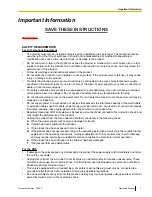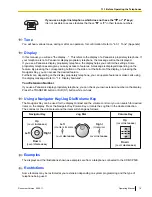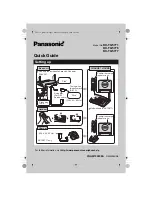
For detailed information about each feature or setting, refer to the Feature Manual or PC Programming
Manual.
•
In this manual, several kinds of PTs appear, as follows:
–
IP Proprietary Telephone (IP-PT)
–
Digital Proprietary Telephone (DPT)
–
Analog Proprietary Telephone (APT)
–
Proprietary Telephone with a Display (Display PT)
"PT" is used as a generic term to represent all of these PTs. If a PBX feature only supports specific PTs,
such as IP-PTs, the available telephone types are clearly indicated.
•
IP-PTs/SIP Extensions may become busy and you may not be able to make or receive calls, depending
on the network status.
•
The contents of this manual apply to PBXs with a certain software version, as indicated on the cover of
this manual. To confirm the software version of your PBX, refer to the PC Programming Manual or PT
Programming Manual.
•
Product specifications are subject to change without notice.
•
The buttons and operations for the KX-NT400 differ from those for the other PTs. KX-NT400 users should
refer to the Operating Instructions of the KX-NT400.
Notes for SIP Extension Users
Before using a SIP Extension, please read the following notes.
a.
The following features are available for SIP Extension users:
–
Making calls
–
Answering calls
–
Holding calls
–
Transferring calls (You cannot go on-hook before the transferred party answers.)
b.
The available operations using feature numbers are limited. Refer to the telephone types displayed at the
top left of each operation.
c.
A KX-HGT100 user can access some PBX features using the feature numbers. Some features are only
available when the firmware of the KX-HGT100 and the MPR software file version of the PBX are upgraded
to their latest versions. Refer to "1.5.1 Operation List". For more details, consult your dealer.
d.
A KX-HGT100 user can store and dial phone numbers in his/her telephone for personal use through
KX-HGT100 programming.
e.
The tones listed in "4.3.1 Tone" are not available for SIP Extension users. Tones or the tone types may
vary depending on the type of telephone being used. For example, when you put a call on hold, a specific
tone for the SIP Extension may be heard, or no tone may be heard.
f.
Any number pressed while hearing a Busy/DND/Reorder tone, such as the feature number to activate
Automatic Callback Busy, will be ignored.
g.
The operations for SIP Extensions may differ from the steps in this manual, and may vary depending on
the type of telephone being used.
4
Operating Manual
Document Version 2009-11
Feature Highlights





































